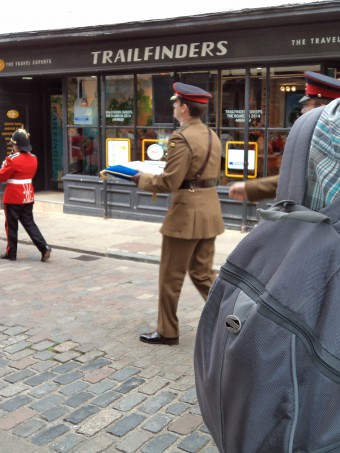Although I hadn’t actually intended to be in the city to see the Magna Carta parade, I happened to be there and so joined the crowd to see the band, the military escort for ‘Magna Carta’, the mayor, civic, church and other dignitaries, and a group of ‘medieval’ townspeople suitably attired. I left them to head into the cathedral precincts for evensong and instead headed towards The Beaney to have a look at Canterbury’s Magna Carta exhibition. The exhibition is in two rooms at The Beaney, in the Front Room is the ‘journey’ towards ‘Our Great Charter’ composed by the Skillnet Group of young adults, looking at what they have learned over the past couple of months as they explored first the General Election before turning their attention to Magna Carta and the freedoms gained by people since 1215. There are a number of interactive features to this exhibition and this is also the case in the other Magna Carta room upstairs.
Canterbury’s Magna Carta parade in Burgate
The exhibition ‘Canterbury in the Age of Magna Carta’ is in the Drawing Room and when I was there a couple of youngsters with their mother were working on their own seals. As you might expect the exhibition makes good use of both William Urry’s maps from his Canterbury under the Angevin Kings and also charters and other documents from the Canterbury Cathedral Archives and Library, one of the exhibition’s sponsors. Canterbury Christ Church University is the other partner under the leadership of Professor Louise Wilkinson, and, as she said in her lecture at the conference, Canterbury is very fortunate in the quality of its medieval records for this period. If you haven’t been to the exhibition, I would recommend you do because it offers interesting materials not only on Canterbury’s own Magna Carta, the city’s citizens in John’s time, but images and artefacts covering pilgrimage to St Thomas’s shrine, including a piece of pink marble that may have been part of the shrine. Similarly, if you haven’t been to Faversham’s Magna Carta exhibition, it too is well worth a visit.
Keeping with the same period I was also present when a group of students (undergraduates and postgraduates) from the University of Kent staged a performance of the first section of ‘The Play of Adam’, that is the section dealing with the Fall, at St Stephen’s church, Hackington. This play dates from the twelfth century and survives in a single manuscript copy. The reason why it is so interesting is that it is in the vernacular, in this case Anglo-Norman and thus could have been performed in any part of the Angevin Empire, including potentially Canterbury. The reason I am drawing your attention to this performance, apart from the fact that it was well done and the actors made good use of the playing space outside the church’s west door, is that it deals very cleverly with several themes that were of deep concern to churchmen and others in authority in the late twelfth and early thirteenth centuries. Among these were ideas about formalising marriage and the marriage ceremony that the Church wished to encourage, especially its solemnisation at the church door, to be followed by a nuptial mass, and something very similar takes place where God joins the hands of Adam and Eve together near the beginning of the play. Similarly, ideas about the feudal bond between master and man take place, in this case between God and Adam, a reciprocal relationship that equally bound medieval society together, at least ideally. Although, as Magna Carta showed, when this bond was broken society became unstable and it was difficult to reinstate ideas of trust between the parties. Moreover by staging the action at the church door and in the churchyard – God retires into the church at various points – the audience, then as now, can understand the spiritual implications put forward by the writer, and for those who had experienced the Interdict in England during John’s reign, such a play might have been especially painful, a reminder of how English people (Mankind and Adam) had been estranged from the Church and thus from God.
The play also featured a very fetching Hell Mouth, suitably positioned on the north side of the playing area and thus the church, and a splendid snake that quivered beautifully at God’s approach, finding itself condemned to crawl on its belly forever. However the play is one of hope because, even though Adam and Eve are driven from Paradise, Satan and his devils plant thistles in Adam’s corn and destroy his crops, the message of the Resurrection is given in several lines and there is an especially good linking of Eve and Mary. This connection might also be seen as joining Creation and Domesday, another theme that was of concern to contemporaries. Thus once again Canterbury has served up some fascinating medieval events this week. On that note, I’ll finish by saying that preparations for the Medieval Canterbury Weekend in 1-3 April 2016, under the Centre, are coming on well, which should mean booking will open in July through the university’s Arts & Culture facility, either in person at Augustine House or through the relevant webpage.
 Centre for Kent History and Heritage
Centre for Kent History and Heritage Sheila Sweetinburgh
Sheila Sweetinburgh 580
580


